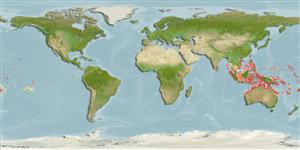Environment: milieu / climate zone / depth range / distribution range
Ökologie
seewasser riff-verbunden; tiefenbereich 2 - 30 m (Ref. 27115), usually 3 - 30 m (Ref. 27115). Tropical; 22°C - 30°C (Ref. 27115); 19°N - 24°S
Western Pacific: from the western and eastern Australia to Tonga; north to Taiwan and the Philippines; throughout Indonesia, Papua New Guinea, Marshall Is., Solomons, and Fiji.
Size / Gewicht / Alter
Maturity: Lm ? range ? - ? cm
Max length : 8.5 cm SL Männchen/unbestimmt; (Ref. 48637)
Rückenflossenstacheln (insgesamt): 7; Rückenflossenweichstrahlen (insgesamt): 15-17; Afterflossenstacheln 1; Afterflossenweichstrahlen: 15 - 17. This species is distinguished by the following characters: D VI + I,15-17 (first 2 dorsal-fin spines filiform, elongate, remaining progressively shorter); A I,15-17; pectoral-fin rays 16-18; united pelvic fins, frenum absent; rounded caudal fin; scale in series, longitudinal 55-61 and transverse 17-19; interorbital wide, 75-100 % of eye diameter; rear margin of upper jaw ending at vertical through anterior margin of eye or slightly behind; scales ctenoid posteriorly, becoming cycloid anteriorly between first dorsal fin and pectoral fin, at axil of pectoral fin, on nape and entire belly; predorsal scales 24-26; scales do not reach level of the posterior edge of the eye on predorsal area, ending at the level of pore G; naked cheek and opercle, in some specimens with a few cycloid scales in upper part; scales cover the basal 1/4-1/6 of the caudal fin, becoming rapidly smaller and cycloid; prepectoral area with about 5-9 vertical series of fine cycloid scales which cover the entire base of the pectoral fin; prepelvic area with cycloid scales, 11-16 in the midventral row (Ref. 119548). Colour of body charcoal grey with 5 dark-edged orange to reddish stripes; upper back with a row of white spots; yellow-edged black spot on second dorsal fin; upper caudal fin base with black spot (Ref. 90102).
Inhabits sandy and muddy bottoms of turbid coastal reefs (Ref. 1602) to depths pf 20m (Ref. 48637). Solitary or in small groups (Ref. 90102). Does not appear to use a burrow and seen in areas with coral growth (Ref. 1602).
Life cycle and mating behavior
Geschlechtsreife | Fortpflanzung | Ablaichen | Eier | Fecundity | Larven
Kovačić, M., S.V. Bogorodsky, A.O. Mal and T.J. Alpermann, 2018. Redescription of the genus Koumansetta (Teleostei: Gobiidae), with description of a new species from the Red Sea. Zootaxa 4459(3):453-481. (Ref. 119548)
IUCN Rote Liste Status (Ref. 130435)
Bedrohung für Menschen
Harmless
Nutzung durch Menschen
Fischereien: nicht kommerziell; Aquarium: Kommerziell
Mehr Information
NamenSynonymeMetabolismusRäuberÖkotoxikologieFortpflanzungGeschlechtsreifeAblaichenSpawning aggregationFecundityEierEientwicklung
ReferenzenAquakulturAquakultur ProfilZuchtlinienGenetikElectrophoresesVererbbarkeitKrankheitenVerarbeitungNutrientsMass conversion
Tools
Zusatzinformationen
Download XML
Internet Quellen
Estimates based on models
Preferred temperature (Ref.
123201): 25.7 - 28.9, mean 27.8 °C (based on 574 cells).
Phylogenetic diversity index (Ref.
82804): PD
50 = 0.6250 [Uniqueness, from 0.5 = low to 2.0 = high].
Bayesian length-weight: a=0.00708 (0.00333 - 0.01504), b=3.09 (2.92 - 3.26), in cm total length, based on LWR estimates for this (Sub)family-body shape (Ref.
93245).
Trophic level (Ref.
69278): 3.3 ±0.4 se; based on size and trophs of closest relatives
Widerstandsfähigkeit (Ref.
120179): hoch, Verdopplung der Population dauert weniger als 15 Monate. (Preliminary K or Fecundity.).
Fishing Vulnerability (Ref.
59153): Low vulnerability (10 of 100).
Nutrients (Ref.
124155): Calcium = 162 [70, 329] mg/100g; Iron = 0.871 [0.406, 1.764] mg/100g; Protein = 17.4 [15.4, 19.2] %; Omega3 = 0.083 [0.035, 0.168] g/100g; Selenium = 26.1 [11.6, 64.3] μg/100g; VitaminA = 113 [23, 528] μg/100g; Zinc = 2.69 [1.66, 4.15] mg/100g (wet weight);
